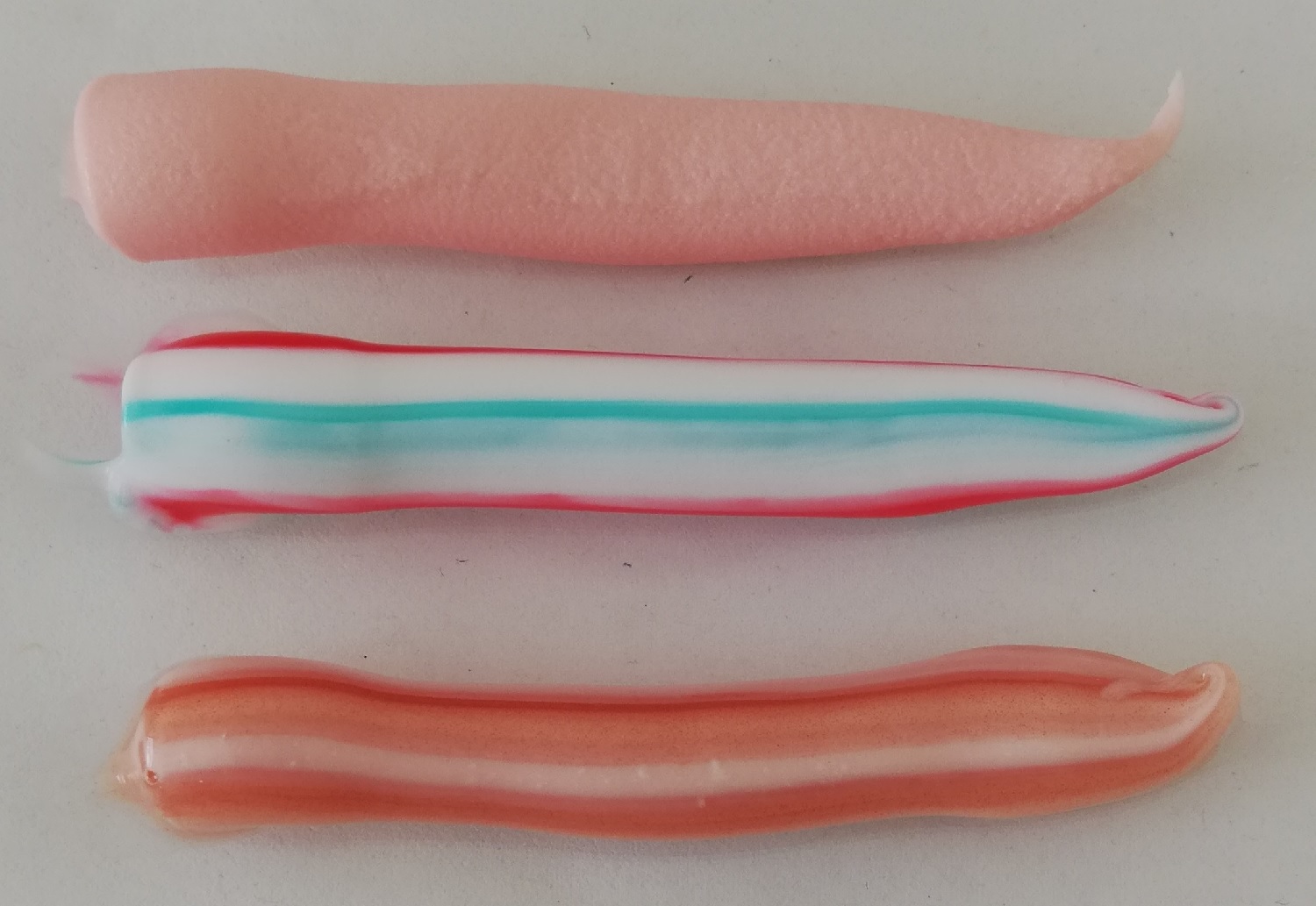Toothpastes are one of the most often and widely used personal care and cosmetics products (PCCPs) among people. Kids, adults, elderly, men and women are using them daily for their oral hygiene. They are defined as a semi-solid material for removing naturally occurring deposits from teeth. It is estimated that regular brushing, at least twice daily, and flossing at least once a day is a good oral hygiene routine. But in Europe, perhaps unsurprisingly, many people claim to brush at least twice a day, although data from surveys suggests otherwise. Tooth brushing habits in different European countries appear to vary considerably with reports of over 75% of adults and children brushing more than once a day in some countries, but less than 45% do so in others [1].

Picture source: A. Bubik
There are a vast variety of toothpastes currently available on the market. While each brand has varying compositions and ratios in their formulas, the basic and common ingredients that can be found in toothpastes are: abrasives, colouring agents, detergents, flavouring, fluoride, humectants, thickeners, preservatives, sweeteners, and whiteners.
… this is a lot of chemicals for common users to recognize and distinguish!
But do not forget, not all the aforementioned chemicals are used in each toothpaste, especially not in verified natural ones.
Abrasives are hard materials used to remove surface material of softer, less resistant materials by grinding or rubbing. Abrasive agents in toothpastes help for the mechanical teeth cleaning and in certain toothpastes, abrasives represent microbeads. Those are manufactured solid plastic particles of less than one millimeter in their largest dimension (for example polyethylene (PE), polymethyl methacrylates (PMMA) …). In cosmetics microbeads can be added as an exfoliating agent also to soaps and facial scrubs. But not only as an exfoliating agent, microbeads can also be added to toothpastes for decorative purposes. Dentists had observed microbeads trapped in the gums of patients, which can pose a serious problem as the area between the teeth and gums is extremely sensitive [2].
GS tip: BE AWARE that besides toothpaste, products like mouthwashes and cleaning tablets for braces and dentures can also contain microbeads!
Many cosmetics formulators and companies are striving to include some natural abrasives into their products – e.g. powdered walnut, almond and pistachio shells, various seeds and pips, salt crystals…
There are a lot of natural alternatives, but let us emphasize what is going on with the synthetic abrasives in PCCPs.

Picture source: A. Bubik
How can we easily recognize the microplastics in our toothpastes?
With the aim to highlight the issue of microbead pollution through PCCPs, the aptly named Beat the Microbead campaign was initiated by the Plastic Soup Foundation in 2012. The foundation provides a list of more than 500 microplastic ingredients, widely used in PCCPs, which can contribute to the global problem of microplastic pollution. Based on the restrictions, proposed by the European Chemical Agency (ECHA), and characteristics of synthetic polymers (if they are persistent, bioaccumulative, and toxic if they are readily biodegradable, and if they pose a risk to human health), PCCPs are categorised into four groups within this project – Red, Orange, Green, & Zero. The categorization is based on the microplastics components in the products. Products on the Red list have been found to contain ingredients which are commonly considered to be microplastic ingredients (e.g. Polyethylene (PE), Polypropylene (PP), Polymethyl methacrylate (PMMA), Nylon (PA), Polyurethane, and Acrylates Copolymer). Products on the Orange list contain “sceptical microplastic” ingredients (e.g. Polyquaternium, Poloxamer, PEGs, and PPGs). Those are synthetic polymers for which there is not sufficient information available about their impact on human and environmental health. Products on the Green list and Zero lists do not contain any microplastic or “sceptical microplastic” ingredients [3].
What data in Slovenia shows?
In 2019 an applicable research on “Synthetic polymers in toothpastes” was performed in Slovenia at the Faculty of Environmental Protection. 186 toothpastes of 30 different brands from the Slovene market were checked for the presence of synthetic polymers based on the available declaration data and then compared to publicly available data of the Beat the Microbead project.
The results emphasised that 55% of examined toothpastes, which belonged to 17 different brands, possessed at least one synthetic polymer as the basic component. Polyethylene glycols (PEGs) were found as the most common plastic component and were present in 70.4% of all examined toothpastes with synthetic polymer content. PEGs comprise a class of polymers and their name is usually followed by a number, which represents the approximate molecular weight of the compound (e.g. PEG-6, PEG-32,…). PEGs and their derivatives (compounds formed from PEG by replacing, adding or removing some parts of a molecule) are used in many cosmetic applications due to their physical properties (like solubility and viscosity), and because of their low toxicity. In the research the most commonly founded PEGs in toothpastes were PEG-6, -8, -12 and -32, PEG – 30/40 Glyceryl Stearate, PEG – 40 Stearate, PEG – 40/60 Hydrogenated Castor Oil, PEG – 3 Tallow Aminopropylamine.
Among toothpastes with the synthetic ingredients only 11% of examined toothpastes (equal to approx. 6% of all examined toothpastes) can be classified into the Red group based on the Beat the Microbead categorization. The result is expected due to the high detected proportion of PEGs in the toothpastes, which belong to the Orange category of sceptic substances. Within our Red group, only two toothpastes were for kids, what correlates to 18% of all toothpastes with microplastic components.
The online public survey in Slovenia showed that we are familiar with the term “microplastics” (78.6%) and more than a half of respondets (62.4%) are aware of the presence of microplastic in their daily life. But only 36.8% of them were aware of microplastics in PCCPs.
Consumers were also not aware of microbeads in toothpastes:
- More than a half (55.6%) of respondents do not know that toothpaste may consist of microplastic ingredients.
- The majority of consumers (91.5%) do not pay attention to microplastic or synthetic polymer ingredients while shopping for toothpaste.
- Almost 77% of respondents are not able to give a name of one synthetic polymer possibly present in the toothpaste.
- Only PEGs are recognized as a plastic component in toothpastes among respondents.
Toothpastes are very frequently used PCCPs among all populations. After use, toothpaste components, dissolved or undissolved in water, become part of the municipal wastewater flow. Besides landing in the sink, toothpaste is swallowed when we wash our teeth, especially by kids. Therefore, it is very important to know what chemicals our toothpaste consists of!
In the case of microbeads, an EU restriction proposal on how and when to limit the use of intentionally added microplastic particles to consumer or professional use products of any kind will help to decrease the widespread microplastic issues in the next decades. In the end, we can do a lot for ourselves and the environment with just a few simple steps.
Sources
[1] Eaton K., Carlile M. (2008): Tooth brushing behaviour in Europe: opportunities for dental public health.International Dental Journal 58 (5), p p. 287-293.
[3] https://www.beatthemicrobead.org/ (October 2022)


0 Comments